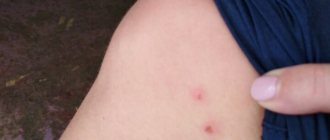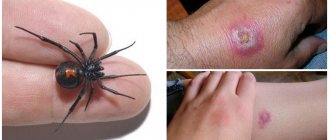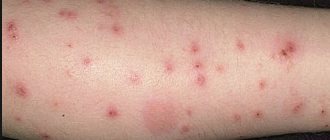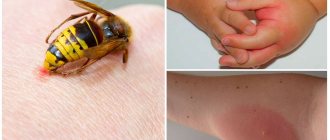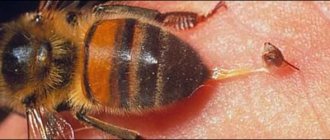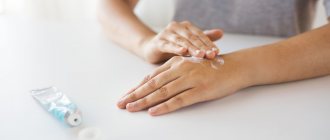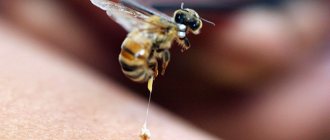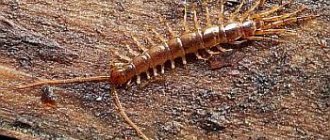- The danger of wasp stings
- Symptoms of the disease
- Providing assistance with wasp bites
- Allergy prevention
Allergy to wasps is caused by the effects of toxins released by wasps on the human body. Often the patient’s condition is complicated by anaphylaxis, which, if medical care is not provided in a timely manner, can result in the death of the patient. According to statistics, about 3% of the world's population dies from the bite of this insect.
It's no secret that people have a much harder time with a wasp sting than a bee sting. In addition, the bee dies after the injection of poison, and wasps are capable of stinging several times and at the same time can attack a person themselves, choosing the most vulnerable places for stings.
What do you need to know if you or your loved ones suffer from an allergy to insect bites?
An allergic reaction to a wasp sting does not develop the same type every time. And if your symptoms are moderate or mild, no one can guarantee that the next bite will not cause more serious consequences. In order to minimize health risks, train yourself to follow these rules:
- Every time before leaving home, check that you have an allergy passport. It is better if all the necessary information is on a special bracelet or in a medallion, access to which is not difficult due to clothing. Your passport must indicate your allergy status; what are you allergic to; allergy medications you take; what first aid equipment you need; your home address and telephone number of your attending physician.
- An anti-allergic (anti-shock) first aid kit should always be with you. Regularly, once every 2-3 months, check the expiration date of first aid medications. If you lead an active lifestyle and are often outside your apartment, pack several first aid kits, each of which will be kept at home, at work, in the gym and other places you most often visit. One of the first aid kits should be with you at all times.
- In the period from April to October, when traveling to nature, to the country, etc., use special insect repellents. Try to wear clothing that is as closed as possible, and do not use perfumes and cosmetics with fruity and floral scents. During the warm season, avoid eating outdoors (summer cafes, picnics, etc.), as this significantly increases the risk of swallowing a stinging insect.
By following these simple rules, you will prevent insect bites and, accordingly, you will be able to avoid allergic reactions.
How to avoid bee and wasp stings?
- Do not leave cut fruits and sweets on the table.
- Immediately remove cores and crusts into a sealed trash bag.
- The container for compotes/juices must have a lid.
- Teach children not to drink from the bottle, especially from opaque containers. First you need to pour it into a glass and inspect the contents.
- Do not use perfumes or creams with sweet or floral scents.
- Do not wave your arms to ward off wasps and bees.
- If you have already stunned the wasp, take it as far as possible without touching it with your hands, since the insect may still be alive, they could step on it with bare feet or put a hand on it.
- Use repellents.
Actions in the first minutes after the bite
Perhaps the first thing you should do immediately after a bite is to make sure that it was a wasp and not a bee that stung: some fundamental aspects of first aid after an attack by these insects vary significantly. So, for example, if you are bitten by a wasp, you should not waste precious time looking for the sting - unlike a bee, this insect never leaves it in the skin.
The task of the initial stage of first aid for a wasp sting is to minimize the amount of insect venom injected under the skin at the site of the bite. There are several ways to do this.
To begin with, you need to try to suck out as much venom as possible from the bite site: this can only take 1 minute, since the skin around the puncture site usually tightens very quickly, and further attempts will no longer be effective.
Don’t be afraid of getting wasp venom into your mouth - it won’t cause any harm, the only important thing is not to swallow it, but to spit it out
There is another more or less effective way to partially neutralize the insect toxin. Wasp venom has an alkaline reaction, so acids are its neutralizers. In order to reduce the amount of the active form of poison in the wound, you should apply a cotton swab moistened with 9% table vinegar, a slice of lemon, or a piece of apple or orange to it for a minute.
In some cases, especially brave victims burn the wasp bite with an extinguished match, cigarette or hot coal. Typically, exposure to high temperature is considered as a first aid method for bites from snakes and some poisonous spiders - that is, when there is a real threat to life. When cauterized, the toxins of the poison located close to the surface of the skin disintegrate and simply do not have time to cause any harm.
Such first aid, of course, will give a certain effect in the event of a wasp sting, but you need to clearly understand that this method, firstly, is very painful (sometimes even more sensitive than the bite itself), and, secondly, a trace of the resulting burn may remain for life. Probably, the only case when it makes sense to seek such help is when the victim is obviously prone to severe insect allergies, and he knows about it himself, but does not have a special injector with adrenaline with him.
In addition to all of the above actions, at the initial stage of first aid, you can put a kind of compress of wet sugar on the wound, which will also draw out the poison from the wound.
Further first aid actions for a wasp sting should be aimed at preventing the poison from quickly entering the bloodstream, reducing the likelihood of developing a severe allergy and relieving symptoms of intoxication of the body. For example, to reduce the rate of spread of poison and reduce swelling at the site of the bite, you need to keep a cold compress for as long as possible - this could be a piece of ice, frozen meat or a bottle of cold water. Just under the cold compress there may be the above-mentioned piece of wet sugar, the hypertonic solution of which will additionally draw out the poison from the wound.
What to do after a bee sting?
After a bee sting, you need to wash the sore spot. Next, you should wash your hands and disinfect the tweezers. Find the sting and carefully pull it out. You can't squeeze it out! The venom may spread further and the bite site will swell more. Disinfect the wound again. You can use hydrogen peroxide or ammonia diluted in a ratio of 1 to 5. Apply a cold compress to the sore spot. This could be a piece of ice or a towel soaked in ice water. Then the person needs to take an antihistamine.
Bee sting to the head
, as well as in the oral cavity and chest, is considered quite dangerous. Therefore, you need to especially carefully monitor the condition of the person who was bitten there. Usually, complications begin to arise within a few minutes (in rare cases, after a few hours). The sequence of actions for a bite to the head is the same as for a bite to any other place. If there is significant swelling and deterioration of the condition, it is necessary to urgently call an ambulance.
The consequences of a bee sting can vary. Ulcers may appear on the sore spot. The patient may have an increase in temperature, fever, and pain.
The risk group that may experience deterioration in health after an insect bite includes children under 12 years of age and the elderly. You can avoid being stung by knowing what attracts bees. They usually fly towards cloying smells, sweets and bright clothes. When they appear, you should not wave your arms so as not to provoke the insect. Try to behave calmly, step aside or, as a last resort, knock down the bee with improvised means.
Bee stings are the most common triggers for insect sting anaphylaxis. We will tell you how to treat a bee sting in this article.
Only one or two people in 1,000 are allergic or hypersensitive to bee stings. Bee stings are incredibly common and incredibly painful. Death from bee stings occurs 3 or 4 times more often than from snake bites.
The African bee, or killer bee, is the most aggressive and attacks in swarms, causing a stronger reaction.
A bee's sting is a modified apparatus for oviposition and is found only in females.
Bees live in colonies and their job is to vigorously defend the nest.
The main chemical element
What causes
pain if stung by bees
is
melittin
.
It stimulates the nerve endings of pain receptors in the skin.
The result is very painful sensation
, such as a sharp pain that lasts several minutes and turns into a dull pain. The tissue around the affected area remains tender several days later.
The human body reacts by releasing fluid from the blood to flush out the poison components. This causes redness and swelling
.
If this is not the first time a bee sting has occurred, then it is likely that the immune system will recognize the poison and improve the “healing” procedure. This can lead to itching, very large swelling
around the affected area or an entire part of the body.
Try not to rub or scratch the area because germs from the surface of the skin will enter the wound and lead to infection.
When stung by a bee, the venom continues to be pumped from the sting for 45-60 seconds, the wound will pulsate
.
You will want to relieve the pain as quickly as possible. So how to treat a bee sting? - you ask. Some substances have proven to be effective, but you must act quickly
for these methods to work.
Cold
– An ice pack, or even just an ice cube, placed over the bite can reduce swelling and keep the venom from spreading.
Warm
– Oddly enough, heat can also make you feel better by neutralizing one of the chemicals that causes inflammation. Just take a hairdryer and point it at your wound or run it under hot water.
Onion treatment
Ammonia
– sometimes ammonia applied to the bite site helps significantly. If it works, it will relieve pain very quickly.
Baking soda
– Apply a paste of baking soda and water.
Bees are beneficial insects. They pollinate plants, which is why we have berries, vegetables and fruits on our table. Don’t forget about such a wonderful product as honey, which appears only thanks to the activity of bees. And in medicine, bee stinging, scientifically called apitherapy, is widely used to treat various diseases.
Meeting bees in life brings not so much joy as pain and disappointment. People predisposed to allergies may have a severe reaction to bee venom, even death. Let's try to figure out what a bee sting brings - benefit or harm. Let's get acquainted with the rules of first aid and treatment.
Causes of bee sting allergy
“Bee sting” is a very conditional name, because a bee cannot bite, it stings.
The sting is a modified ovipositor, which is located at the rear end of the body, and is used for attack or self-defense. A bee stinger has barbs that get stuck in human skin. As a result of this, during an attack, it is torn off from the insect’s body, dooming it to inevitable death. Thus, a bee can only “bite” once. But wasps and hornets have a smooth sting, thanks to which they can sting several times in a row. The sting releases poison into the human blood, which is a mixture of many biologically active substances, including the pro-inflammatory mediator histamine, various proteins (enzymes phospholipase, phosphatase, etc.), peptides, amino acids, etc. It is proteins that in most cases turn out to be allergens that can provoke an inadequate immune response. When they enter the blood of a person suffering from hypersensitivity, a large amount of IgE antibodies are produced, triggering a cascade of reactions that lead to typical manifestations of allergies.
When the poison first enters the body, the allergic reaction may be barely noticeable, but all subsequent ones will lead to more serious symptoms, since antibodies to the allergen remain and accumulate in the blood.
Why are some people so sensitive to bee venom? The answer to this question is not so simple. The reason lies in the imperfection of the immune system, which recognizes a certain foreign protein (allergen) as potentially dangerous.
People who are hypersensitive to the poison also cannot tolerate honey, wax and other bee products. This happens because all these substances contain impurities of bee enzymes.
At the same time, some people cannot eat honey, but the bites do not cause them any symptoms that are not normal. In this case, one can suspect that a hypersensitivity reaction to honey is provoked by pollen contained in large quantities.
Differences between a bee sting and a wasp sting
Wasps are showing aggression. They give a reaction to a stimulus: gesturing with hands, a strong aroma of perfume, bright clothes. Scientists note that wasps are especially cruel in August. Bees can sting only if their life or nest is in real danger.
A killed insect releases specific substances that signal danger to the Hymenoptera family. In this case, you can be attacked by a whole swarm of stinging insects. The correct behavior when an insect that can bite appears nearby is calm and still.
The bee leaves its sting after stinging in the skin of a person. She can only sting once in her life. After she bites, this bee dies. Wasps sting repeatedly. During the bite, the sting penetrates any part of the body and poisonous toxins are injected. An allergic reaction is caused by animal protein, which at this moment enters the human blood and causes the body to produce antibodies. Wasp venom contains quinine. It dilates blood vessels.
Common symptoms of normal and allergic reactions
Despite the differences in chemical composition, the general symptoms of a normal body reaction to a hymenoptera bite are approximately the same:
- Burning pain;
- Papule surrounded by swelling and redness.
On average, these symptoms last from 1 to 5 days.
Allergic reaction
It usually develops from bites on the hands, neck, face, or tongue. When bitten on the legs or chest, the reaction develops much less frequently.
Allergic reaction to a wasp sting on a guy's face. Before and after the reaction (can be increased)
According to the extent of symptoms, allergies are classified as general and local.
The local reaction is relatively safe for life, develops in the bite area, and is manifested by swelling, itching and redness of the entire affected limb.
A generalized or generalized allergic reaction is life-threatening and requires immediate medical attention. Local reactions rarely develop against the background of general reactions.
The classification of general allergies according to the severity of manifestations includes three degrees:
- First degree (mild). It manifests itself as urticaria, Quincke's edema (swelling of the lips, tongue, larynx, ears), low blood pressure. Edema of the larynx leads to hypoxia or asphyxia, which can lead to death.
- Second degree (medium). In addition to the symptoms described above, vomiting, diarrhea, abdominal pain, bronchospasm are added, low blood pressure is manifested by general weakness and periodic loss of consciousness.
- Third degree (severe). Anaphylactic shock is a rapidly developing and most dangerous manifestation of allergies. In the first minutes after the bite, a severe headache appears, itching spreads from the bite site throughout the body, bronchospasm develops, and soon the person loses consciousness. In this case, convulsions and involuntary urination are possible. The skin is pale, cyanotic, cold sticky sweat appears on the skin, blood pressure drops to 80/40 mmHg. Art., collapse develops, the pulse is practically not palpable. Death occurs within a few hours or even minutes due to hypoxia of vital organs.
Photo: allergies after a wasp and other stinging stings
A swollen hand after a bite and a healthy one
Reaction to a bumblebee sting on the leg
Systemic reaction - rash all over the body after a sting
Quincke's edema is a serious systemic reaction
Swelling on the lip after a sting
Hyperemia at the bite site
Toxic reaction
Along with an allergic reaction, a toxic reaction can develop to the sting of a bee and other hymenoptera insects, since their venom has high biological activity.
A toxic reaction can occur in both an allergic person and a healthy person.
And if for an allergic reaction one bite is enough, since the main role in it is played by the antibodies in the body, for a toxic reaction the amount of poison in the body, depending on the number of bites, plays a decisive role.
A toxic reaction, just like an allergic one, is divided into local and general. Local is manifested by slight swelling, redness, itching, which lasts up to a week.
Clinical symptoms of general intoxication:
- heat,
- nausea and vomiting,
- headache,
- in severe cases, convulsions and delirium,
- inhibition of the blood coagulation system,
- increased vascular permeability.
Please note: Resistance to bee venom is individual for each person and depends on gender, age, and body weight. A one-time sting from more than five hundred bees almost always leads to death.
Special cases
Acute allergic reaction - Quincke's edema (can be increased)
What could be the consequences if a bee (or other insect) stings you on the head?
A bee sting on the head poses considerable danger - the consequences can be quite serious (encephalitis, neuritis, etc.). Swelling occurs from a few minutes to several hours after the bite. Therefore, if a bee stings your head, you should immediately contact a medical facility.
Sudden allergy to bee venom. And is it an allergy?
Many people are interested in the causes of a sudden allergy to bee venom (and is it an allergy?). Cases have been described where the bite initially did not cause significant manifestations of allergies. But subsequent insect bites were accompanied by such terrible symptoms as anaphylactic shock and Quincke's edema.
In this case, the first insect bite is a kind of “acquaintance” of the body with the allergen. With subsequent bites, the immune system reacts more aggressively. Sometimes the opposite process occurs: sudden desensitization, which manifests itself in such a way that the reaction becomes weaker with each new bite
Diagnostics and immunotherapy
Even if a person has not previously been exposed to allergic diseases, this does not guarantee the absence of a reaction to the venom of these insects. You can identify a predisposition to such a reaction by undergoing an allergy test.
If the detection of insect allergies to the venom of bees, wasps and other insects gives a positive result, immunotherapy is performed. This treatment involves injecting microdoses of a toxic substance using a syringe. By tracking the body's response to an introduced stimulus, the level of sensitivity of the immune system is determined.
During the course of therapy, the body adapts to the poison and no longer gives a strong reaction to it. Such “training” suggests that a real insect bite will not cause a severe allergic reaction and will help get rid of allergies that occur after a stinging insect bite.
The Ministry of Health told what to do if you are bitten by a wasp or a bee
How to help a person who has been bitten by a wasp or bee? The Ministry of Health published a special memo in which it told what to do if you are bitten by stinging insects - in addition to bees and wasps, these also include bumblebees, hornets, and gadflies.
Attention! Department experts report that even one bite from such an insect in a few minutes can lead to death if a person suffers from allergies. 500 bites can lead to death in a person who is not prone to an allergic reaction, although there are cases of lucky people who survived even after 2000. Doctors say that the less time passes before symptoms develop, the worse the prognosis
The reaction usually occurs within a few minutes (up to an hour). There may be short-term pain, redness around the bite site, itching, fever
Doctors say that the less time passes before symptoms develop, the worse the prognosis. The reaction usually occurs within a few minutes (up to an hour). There may be short-term pain, redness around the bite site, itching, and fever.
Redness of the skin, the appearance of hives, limited swelling of the lips, tongue, sore throat, shortness of breath, abdominal cramps, and diarrhea should alert the victim - these are alarming symptoms. Doctors include greyish-bluish skin color, convulsions, loss of consciousness and inability to breathe due to swelling of the respiratory tract.
It is because of this swelling, when a person cannot breathe, that 40-60% of deaths occur. Doctors advise people prone to allergies to wear a medical bracelet or necklace just in case, which would indicate their possible reaction to bites. Bites to the eye or mouth, as well as multiple insect bites, are especially dangerous for them.
For others who don't have allergies, bites to the throat pose a danger - for example, if they swallowed an insect that got into their food or inhaled a wasp that flew too close to their open mouth. In this case, swelling of the airways may also occur.
Ministry of Health experts advise providing first aid to victims of stinging insects as follows.
- Inspect the bite site and make sure there is no sting left in the skin. It can only remain after a bee sting. If necessary, remove the sting, because poison continues to be released from it for 2-3 minutes after the bite. Pry the sting with your fingernail or the blade of a knife or scissors - do not squeeze the end of the sting protruding above the skin with your fingers.
- Wash the bite with soap and water or wipe with alcohol.
- Apply an ice pack for 15-20 minutes to slow the absorption of the poison and reduce pain.
- To reduce pain and itching, take analgesics (paracetamol). This is usually enough.
- The bite site can be lubricated with an ointment or cream containing corticosteroid hormones (hydrocortisone) to relieve itching and swelling. With early use, antihistamines (Diphenhydramine, Suprastin, Claritin) can eliminate local symptoms.
Observe the victim's condition for at least 30 minutes, paying attention to the development of signs of an allergic reaction. A victim prone to allergies can be given Prednisolone or other antihistamines
But doctors warn: antihistamines in tablets are best taken for prevention - they act too slowly, so they cannot help with a life-threatening allergic reaction.
For severe allergy sufferers, Adrenaline can help (without a severe allergic reaction, it cannot be administered for bites) - the drug does not act for long, so if necessary, it is administered every 15 minutes, monitoring the patient’s condition and recurring signs of an anaphylactic reaction.
Symptoms of the disease
Allergies to wasp stings depend on the location of the stings. A bite to the neck, lymph nodes and face is extremely dangerous. Allergic symptoms are characterized by the following clinical picture:
- the presence of acute pain in the place where the wasp bit;
- hyperemia and edema spreading to nearby tissues;
- unbearable itching, dry mouth;
- difficulty breathing, vomiting, headache;
- nausea and dizziness;
- development of Quincke's edema and anaphylaxis;
- hyperthermia accompanied by chills;
- arrhythmia, hypotension;
After being bitten by an insect, a person may suddenly lose consciousness, which requires urgent action.
An allergic reaction is deadly if it affects the respiratory system. In this case, a powerful release of histamine leads to swelling of the mucous membranes of the larynx, trachea and throat, which is accompanied by sudden bronchospasms. The patient cannot breathe normally, which causes panic and increased spasms. Whistling sounds appear when breathing and suffocation. Cardiovascular disorders are accompanied by a sharp drop in blood pressure and increased heart rate, which provokes clouding of consciousness and fainting.
Such symptoms require emergency assistance. It should be remembered that the faster negative symptoms grow, the more difficult it is to neutralize an allergy attack. Statistics show that when an allergic reaction occurs in the first 2 minutes after the toxin enters the blood, 50% of all similar symptoms end in the death of the patient.
Why is a wasp sting dangerous?
The danger posed by a wasp sting lies in the possible repeated injection of poison, and the wasp has plenty of it. Unlike bees, wasps, especially hornets, are capable of inflicting more than one bite, each time injecting a toxin into the human body.
Why is a wasp sting dangerous? The unusually high concentration of biologically active components in the poison with a single injection, as a rule, does not have a toxic effect. However, repeated entry into the bloodstream can provoke a severe allergic reaction, the consequence of which, at best, will be Quincke's edema, at worst, anaphylaxis and death.
In addition, wasps are considered predatory insects; they do not engage in productive activities like bees. On the contrary, wasps not only willingly attack their living counterparts - flies, spiders, and other insects, they also happily eat carrion in various garbage bins and other unattractive places. When attacking a person, the wasp uses a sharp sting to damage the skin, resulting in a small, but still wound. Various bacteria can get into it, which most likely covers the wasp's weapon. This is how inflammation develops at the site of the bite, which often develops into a purulent infectious process.
An allergic reaction to a bite also looks threatening, which in clinical practice is diagnosed as a reaction of grade III severity. Vascular collapse, myocardial ischemia, bronchospasms, hemiparesis (partial paralysis), damage to the central nervous system, systemic necrotizing angiitis (vascular pathology), Henoch-Schönlein syndrome (hemorrhagic vasculitis) - this is a far from complete list of answers to the question - why is a wasp sting dangerous? To avoid these threats, you should be careful and try to minimize the possibility of attracting wasps. It's pretty simple to cover your food, avoid insect-provoking scents, and screen your windows, at least during the summer.
Allergy to hornets
The hornet is one of the largest representatives of wasps. Its distribution area is temperate latitudes. They are colored like “ordinary wasps” - yellow stripes on the black body
Photo: Hornet
Aggression level: low.
Sting: does not remain in the skin.
The hornet is an insect known to many beekeepers (the damage caused by hornets can be quite significant). Sometimes it happens that hornets nest directly in bee hives.
Destroying a hornets' nest is dangerous because they can be very aggressive.
Hornets not only feed on nectar, but also kill bees by partially eating them.
Photo: Hornet sting
The composition of the venom differs from that of bees:
- acetylcholine;
- histamine;
- phospholipase A2;
- mastoparan;
- orientotoxin.
The hornet's sting is extremely painful. Asian hornets are especially dangerous (their European counterparts are more peaceful).
Hornet allergy manifests itself:
- severe tissue swelling,
- inflammation,
- pain,
- increased temperature, heart rate and blood sugar levels.
In severe cases, this is Quincke's edema or anaphylactic shock.
Are insect bites dangerous?
Many are sure that the only thing a victim can remember about an insect bite is a tumor. However, the realities tell a completely different story: the mortality rate from Hymenoptera bites is more than 3 times higher than the mortality rate from poisonous snake bites. The reason for these indicators is that 80% of the world's population is allergic to proteins that enter the human body along with the saliva or venom of Hymenoptera.
How else can insect bites be dangerous? Firstly, these creatures are often carriers of various microorganisms that can cause severe diseases in the bitten person, such as typhus, West Nile fever and leishmaniasis, sleeping sickness and dysentery, Lyme disease and encephalitis. This is not a complete list of diseases that can be transmitted by blood-sucking insects, which include fleas, lice, mosquitoes and mosquitoes.
Features of wasp stings
Insects are active in hot weather, so it is not surprising that they are especially aggressive in the second half of summer - July-August. When going outdoors, avoid clothes in bright colors, as well as perfumes with a sweet aroma. You should not overuse sweet fruits and drinks at picnics - wasps react to them instantly, and therefore their presence cannot be avoided.
With the help of its sting, the insect is not only able to lay eggs, but also ensure the injection of toxic components into the victim’s body. Neurotoxins cause a strong effect on human cells, which activates an increase in blood pressure, swelling of the mucous membranes, and changes in the condition of the respiratory muscles.
Unlike the poisonous components that enter after a bee sting, wasp toxins are represented by acetylcholine and histamine in large quantities. They are dangerous for children, the elderly, pregnant women, people with weakened immune systems and a number of diseases. Wasp venom consists of the following components:
- Acetylcholine, which irritates nerve endings, resulting in serious pain.
- Histamine, responsible for allergic manifestations and the development of negative reactions. It provokes the movement of the toxin throughout the body.
- Cytotoxins - have a destructive effect on the wall structure of blood vessels, causing the appearance of hematomas.
- Phospholipase, which destroys cellular structure, causing swelling and inflammatory changes.
Insects prefer to live in areas with accumulations of garbage, which means they spread infections.
Once in the blood, the toxin components begin to move throughout the body, which becomes the cause of allergic symptoms. The concentration of these components can be high, since one bite from an insect sometimes produces several doses. There is another danger - wasps not only inject poison, but can also carry various pathogenic components on the surface of their bodies. This is due to their habits.
What to do if you are stung by a wasp?
In order to minimize the consequences of a wasp sting, the first thing you need to do is try to suck out the poison from the wound (without spending more than 60 seconds on this after the insect attack), then treat the affected area with an antiseptic and apply a cold compress as soon as possible
Cold will constrict the blood vessels and reduce the penetration of poison into the bloodstream - for allergy sufferers this is very important, since while the poison is localized, the negative effect it has on the body is generally minimal, and the active components of the poison continue to be continuously destroyed in the tissues
Subsequently, the affected area can be treated with Fenistil gel or Advantan ointment.
Further consequences of the bite can develop in three scenarios, each of which requires taking appropriate measures.
The first case is the most favorable: a small tumor remains at the site of the wasp bite, which itches or hurts, but the general condition of the bitten person is normal, he does not have a fever, no headache, and the bite does not interfere with ordinary daily activities.
In this situation, it is recommended to treat the affected area with a suitable ointment or balm for insect bites. This way the wasp sting will go away as quickly as possible. However, when choosing a product, you should always carefully read the instructions for it, because it may turn out that it is contraindicated for you.
For example, Advantan ointment has a hormonal effect, which precludes its use on large areas of skin and on the delicate skin of babies under 4 months of age. Hydrocortisone ointment works in much the same way; but the drug “Fenistil” is considered the most universal in this regard - it can be used even in children older than one month.
The second scenario is the most common, although less pleasant: there are no severe allergy symptoms, but the pain at the site of the bite is quite severe, the swelling and swelling have spread throughout the surrounding tissues. The pain in this case may interfere with the person's ability to work and rest normally, and the swelling may become too large.
In this case, the role of a cold compress is especially important. It can also be useful to treat the affected area of the body with antihistamine or hormonal ointment - Fenistil-gel, Advantan, hydrocortisone ointment. All of them have a pronounced anti-inflammatory effect, inhibit tumor development and relieve pain. It is advisable that the ointment be on the skin at the site of the bite constantly until the tumor has subsided significantly.
It is also necessary to consult a doctor (by phone) regarding taking antihistamines in tablets (Suprastin, Diphenhydramine). If the pain syndrome is too severe, then you can additionally use Menovazin, as well as painkillers in tablets.
In this situation, the victim needs to drink as much as possible so that all the products of tissue damage are quickly eliminated from the body, without leading to a deterioration in well-being.
And finally, the rarest, but also the most severe and dangerous case is the development of a severe allergic reaction. Often the situation first develops according to the second scenario, with rapid tumor growth and severe pain, and then more severe symptoms begin to appear. They can be different: headache, nausea, fever, rashes on the body, swelling in places remote from the bite site, allergic runny nose, shortness of breath, asthma attacks, heart pain, sometimes diarrhea or vomiting.
The appearance of these symptoms is a signal to take emergency measures:
It is important to understand that sometimes severe allergic reactions develop not just quickly, but with lightning speed. In the practice of many doctors, there were situations when the patient experienced anaphylactic shock before the doctor had time to take an ampoule of adrenaline out of the box and give an injection
Therefore, at the first alarming symptoms, you need to immediately begin transporting the bitten person to a doctor, so that in the most severe condition the person is already under the control of specialists. This is exactly the situation when a person’s life can directly depend on your correct and timely actions.
How to prevent wasp attacks and what to do in critical situations
It is not an exaggeration to say that wasps are one of the most aggressive species of insects that become active in the summer.
For this reason, it is important to know what to do when attacking this creature. The tactics described below will help you avoid serious consequences of an attack.
Poisonous insect bites
Insects and arthropods that directly contain and release toxic substances into the tissue of the victim at the time of the bite include scorpions and spiders (karakurt, tarantula). Other types do not inject toxic substances, only allergens. Those components that remain in the tissues after a bite can cause toxic reactions, but they are not caused by the action of the poison, but by the body’s allergic reaction to a foreign substance. Most often, such consequences arise from wasp and hornet bites.
The bites of poisonous insects resemble snake bites in their manifestations and the composition of the poison. The basic toxic components of the venom are neurotoxin and hemolysin. The first causes damage to nerve tissue, the second - to blood elements (primarily red blood cells).
Symptoms of a poisonous insect bite are as follows:
- Sharp burning pain at the time of the bite;
- The appearance of a pinpoint wound on the skin;
- Whitish swelling in the form of a tubercle around the bitten area or its rapid spread to surrounding tissues;
- Formation of hemorrhages, red, purple spots or bloody blisters on the skin around the bitten area;
- A sharp deterioration in health: headache, dizziness;
- Numbness of the affected limb;
- Increased body temperature;
- Reduced blood pressure.
If you have the listed symptoms or suspect a poisonous insect bite, you should definitely seek medical help at a medical facility. It is better to monitor the patient for a short time, constantly assessing vital signs and laboratory data, so that timely action can be taken if necessary.
How to behave correctly at the pre-hospital stage?
- No panic, no matter what happens. Calm behavior helps in providing complete assistance. Vanity will not lead to anything good;
- The victim lies down or takes a semi-lying position;
- If the bite is caused by a stinging insect (bee, wasp), the remains of the sting must be removed from the skin;
- A pressure bandage is applied to the segment above the bite site. There is no need to apply a tourniquet. The bandage involves superficial compression of the skin and saphenous veins in the affected area. Arterial blood flow should not be affected;
- Cold compresses, objects, or ice packs are applied to the bite site. This slows down the absorption of toxic products and their distribution in the bloodstream;
- Some doctors recommend cauterizing the bitten wound with a hot object (metal, match). In this case, there is an increase in pain at the site of the bite, but systemic toxic reactions decrease.
Assistance in a medical facility:
- First of all, the possibility of administering specific antitoxic immune sera should be considered. But this can only be done if the culprit of the bite is precisely known and is a spider or scorpion. Serum is the most effective remedy and has a neutralizing effect on the very source of pathological changes in the body - poison;
- Pathogenetic treatment. It is aimed at eliminating the changes that the toxin has already caused. Includes massive infusion therapy with colloid and crystalloid solutions, diuretics, glucocorticoid hormones;
- Anti-shock measures if necessary;
- Symptomatic therapy - painkillers, anti-inflammatory drugs, lowering body temperature, local treatment of the skin in the bite area.
Fortunately, single bites from most poisonous insects rarely result in serious consequences. Much more dangerous are multiple bites from several insects of the same or different species.
First aid for a wasp sting
As a rule, few people know what to do in case of an insect attack. In a situation where a wasp stings, a person needs first aid
This is especially important for people suffering from dermatitis or bronchial asthma. If there is a delay, such victims may experience an allergic reaction in the form of angioedema with all the unpleasant consequences arising from this condition.
Plus, it’s important to be able to differentiate between bee and wasp stings, which is easy to do once after seeing a photo of these creatures. It should be said that, unlike honey-bearing workers, their aggressive relatives do not die after an attack and do not leave a sting in the human body
Basic knowledge about the rules of behavior in the event of a wasp sting will help both the patient and the people around him to take timely everything necessary to reduce the fruits of animal aggression. So, what to do if a person is bitten by a wasp:
- Rinse the affected area thoroughly.
- Disinfect the wound.
- Apply a salt compress to prevent the absorption of wasp venom.
- Take an antihistamine to prevent the formation of edema in the form of a large, dense tumor.
- Drink plenty of fluids.
- Take an analgesic if the pain is severe.
If a wasp bites you on the lip
The area of the face and neck is considered more dangerous in terms of the likelihood of negative consequences of an attack by this creature. At the same time, if you do not know what to do after a wasp sting, then it is best to contact a medical facility. This is especially true for those who have been stung on the lips by the aggressor. The skin-muscular folds surrounding the entrance to the oral cavity are equipped with a large number of blood vessels, which only contributes to the rapid manifestation of the clinical picture in the victim after a wasp sting.
For the same reason, a poisonous secretion can quickly penetrate into nearby respiratory tracts and cause suffocation, as a result of which victims sometimes even die. The areas of closest spread are usually considered to be the tongue and nasopharynx. If these areas are affected, treatment should begin with antihistamines. It is also possible to relieve the symptoms of a bite by applying local anti-inflammatory drugs in the form of ointments and gels with a cooling effect.
If a child is stung by a wasp
A child's body is more susceptible to insect venom, which can provoke the most unpredictable reaction. As a result, if you are currently looking for information about what to do if a child has been bitten by a wasp, it is better to immediately go to the hospital, where the wound will be thoroughly treated. In case parents have an idea of how to combat the consequences of insect aggression, it should be additionally taken into account that the general symptoms of intoxication in a child can be relieved by drinking plenty of salted boiled water.
Dr. Komarovsky advises that if a child has a pronounced allergic reaction, apply ointment with corticosteroids to the wasp bite area. If symptoms of difficulty breathing appear, immediately administer prednisolone or dexamethasone intramuscularly to the little victim, and then immediately go to the hospital. In the normal condition of a non-allergic child, the situation, according to the pediatrician, can be resolved at home.
Traditional methods for bee stings
In case of minor reactions (redness or swelling of a small area), as well as in the absence of other medications, treatment (provide first aid) can be carried out using improvised means. For example, by dissolving one tablet of aspirin and activated carbon in a glass of water, you can obtain a product that adsorbs insect venom. If you soak a cotton pad or cotton-gauze swab in this solution and apply it to the wound immediately after a bite, you can reduce the amount of poison in the body.
- Onion juice has the property of binding the components of the poison, so it can also be used by applying halves of the vegetable or its pulp to the wound.
- Bee stings can be treated with aloe juice. They need to lubricate the wound up to five times.
- Calendula tincture and baking soda solution are suitable as an antiseptic. Soda dissolves in a ratio of 1 teaspoon per glass of water.
When to see a doctor
Despite the abundance of modern ointments and folk remedies, it is not always enough to simply anoint a wasp sting at home. In some cases, you need to contact a doctor and the sooner the better.
You need to go to the doctor if:
- There is a bite from not one, but several wasps on the body. If a person is bitten by several wasps or bees at one time, then he should immediately go to the hospital, since general toxicity of the body is likely to begin.
- If the wasp has bitten the tongue, mouth, larynx or lip. In this case, you cannot waste a minute, since the swelling from the bite will spread throughout the entire larynx and this will lead to suffocation.
It is also worth contacting a specialist if you are stung by a wasp. Such a bite does not have such terrible consequences, but you still need to visit a doctor.
If you are in doubt whether to go to the doctor or not, then choose the first option. After all, just a 15-minute appointment with a doctor can significantly alleviate the condition, and in some cases even save a life.
Few people do not know what a wasp sting is: its consequences are familiar to almost every adult, many from childhood memory. Severe pain, redness, swelling and itching - this is the standard reaction to a wasp sting.
Meanwhile, the consequences of attacks by these insects can be much more severe. Why is a wasp sting dangerous? Let's find out...
First of all, the bites of hymenoptera insects (which include wasps, hornets, bees, and some others) are distinguished by their high allergenicity. In addition to toxins that destroy the cell walls of affected tissues and affect nerve endings, wasp venom also contains substances that can cause a powerful immune response in the body.
If a person does not have hypersensitivity to wasp venom, he may not feel these allergens. If the victim is hypersensitive (such people are also called sensitized), a wasp sting can be even more dangerous for him than, for example, an attack by a poisonous spider.
The most unpleasant thing here is that no one really knows whether he has such sensitivity or not. It can be congenital, or it can develop over time in response to the bites of various insects. Therefore, complications after a wasp attack can arise unexpectedly and for anyone.
Reaction to bee venom in children
What to do if a bee stings a child? Allergy to a sting in children is less common than in adults, but its manifestations are more pronounced because the child’s body reacts more violently to a bee sting. Children under 10 years of age are at risk, that is, at this age a complex allergic reaction is more likely. Multiple bites are especially dangerous for a small child, as the proportion of the amount of poison to body weight increases. In addition to allergens, in this case the condition is complicated by toxins that are practically safe for adults.
The symptoms of insect allergy in a child are the same as in adults - redness and swelling of large areas of the skin, cough, nausea, chills in a mild form. The severe form is manifested by fainting, diarrhea, and spastic pain in the abdominal cavity. If there are the most minor symptoms - hives or slight swelling, first aid should be provided immediately. Effective treatment in the first half hour is to give antihistamines, and then immediately show the child to the doctor.
What provokes the development of a negative reaction
The insect's stinger, located at the back of the body, is used for protection. The bee's sting has large serrations; when bitten, it remains in the human body, and the bee dies. Hymenoptera can sting once. Wasps, bumblebees, and hornets have stings with small serrations; insects can sting a person repeatedly. When an insect bites, it injects a toxin into the victim's body. Composition of the toxin: biologically active substances, enzymes, proteins, peptides, amino acids. The protein in the poison most often provokes a negative reaction. The protein that enters the blood of an allergic person triggers the production of antibodies, which leads to the development of allergic reactions.
Wasp venom contains quinine, a substance that dilates blood vessels and provokes an acute inflammatory process. The hornet toxin contains acetylcholine, which lowers blood pressure and slows down the heart.
The initial exposure to the toxin may result in subtle symptoms. If the injury is repeated, the body will react much stronger.
Hereditary factors, weakened immunity, external factors, and increased sensitivity to bee products are risk factors.
Allergy to bumblebees
Photo: Bumblebee
Level of aggression: low.
Sting: the structure of a bumblebee's sting is different from that of a bee (in bees it is jagged, so it remains in the wound, while a bumblebee with a smooth sting can attack repeatedly).
Working bumblebees (females) have a sting and, contrary to popular belief, can cause considerable damage to human health. A bumblebee is less aggressive than a bee or, especially, a wasp, but it can sting. It is quite difficult to provoke a bumblebee's aggression, but it will defend itself if you try to destroy its nest or try to kill it.
Bumblebees can be aggressive from the smell of alcohol, perfume or metal (for example, the smell of metal jewelry). The annoying color for bumblebees is blue. This also needs to be taken into account.
If a person is not allergic to a bumblebee, the bite is manifested by slight redness, soreness and local swelling of the tissue.
Allergy to bumblebees manifests itself:
- severe redness of a large area of skin,
- severe skin itching,
- hives,
- tissue swelling,
- nausea,
- vomiting,
- symptoms of anaphylactic shock (drop in blood pressure, breathing problems, confusion).
Normal body reaction
During the bite, the insect sprays poison under the skin, which causes a defensive response from the body. Instant pain, redness, swelling, swelling around the damaged tissue, and a local increase in temperature appear at the site of the lesion. After some time, as the wound heals, itching of medium intensity is observed. This reaction is present in most victims.
The body itself stops the effect of the poison and restores damaged tissue. Painful symptoms disappear within 24 hours; the speed of healing of the bite site depends on the sensitivity of the skin. Approximately a bruise after a wasp sting disappears in 5-7 days.
The situation does not require special treatment, it is enough to provide the correct first aid. To eliminate unpleasant sensations, folk remedies are used in the form of lotions, wiping the wound, compresses, and pastes.
Treatment
Allergies after a wasp sting are treated with antihistamines. The tablet should be taken immediately after the bite is detected. This can be any drug available in the home medicine cabinet - from Loratadine to Alerzin.
Then the bite site must be disinfected with hydrogen peroxide, brilliant green or chlorhexidine. Wasps usually do not leave their stinger in the skin unless the insect has been killed, in which case the stinger will have to be removed with tweezers or a needle.
To reduce swelling, apply a cold compress to the affected area. You can take a few ice cubes, wrap them in a scarf or towel, and hold them on the wound for 5-10 minutes. It is recommended to apply an antihistamine ointment, for example, Fenistil gel, to the skin.
In case of acute allergies, urgent therapeutic measures are required, which are best handled by a doctor. When angioedema develops, an injection of adrenaline is given. To stop the spread of the neurotoxin, wrap the affected limb with a tourniquet and apply a cold compress. At the same time, you need to call an ambulance to your home.
Medical assistance is urgently needed in the following cases:
- allergies in a child under three years of age;
- rapid increase in swelling;
- the presence of several bites;
- confusion;
- paralysis of the affected area.
In some cases, hidden intolerance to wasp venom may occur. There are no visible symptoms, but the person suffers from severe pain in the stomach, accompanied by loose stools and dark urine.
